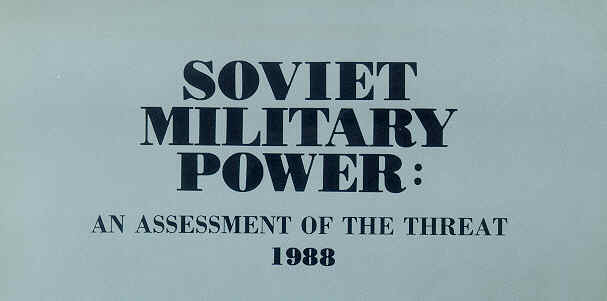CHAPTER IV - Soviet Strategic Programs and Space Forces - part 1
During the past decade, the Soviets allocated resources equivalent to approximately $400 billion to both strategic offensive and defensive programs in almost equal amounts roughly $20 billion per year for each program. Space programs during this same period approached $80 billion.
Since 1981, Soviet strategic nuclear offensive forces have been upgraded as deployment of a fourth generation of intercontinental ballistic missiles (ICBMs)(the SS-17, SS-18, and SS-19) was completed. In 1985, the Soviets introduced the road-mobile SS-25, and in 1987 they began deployment of the rail-mobile SS-24 ICBM. In the Soviet ballistic missile submarine fleet the TYPHOON, carrying 20 SS-N-20 MIRVed (multiple,independently-targetable reentry vehicles) missiles, was introduced, followed closely by the new DELTA IV carrying the even more capable SS-N-23. Soviet long-range bomber capabilities were enhanced by the introduction of the BEAR H carrying the AS-15 nuclear-armed cruise missile. Deployment of the new long-range strategic bomber, the BLACKJACK, is imminent.
In the area of strategic defense, the Soviets are modernizing the ballistic missile defense system around Moscow by replacing 64 old, reloadable above-ground GALOSH launchers with a two-layer defense composed of silo-based, long-range, modified GALOSH interceptor missiles; silo-based GAZELLE high acceleration end atmospheric interceptor missiles; and associated engagement, guidance, and battle management radar systems, including the new PILL BOX phased-array radar near Moscow at Pushkino. This phase of the modernization program should be completed in the late 1980s.
In space developments, the Soviets have orbited their MIR space station, established new endurance records for men in space, flight-tested a subscale model of what appears will become their space plane, and deployed a new medium-lift launcher, the SL-16. In addition, the Soviets launched their heavy-lift SL-X-17, capable of carrying payloads in excess of 100,000 kilograms. The SL-X-17 will also be used to launch the Soviet version of the space shuttle, which the Soviets acknowledge has undergone flight testing under its own power.
These are but a few examples of the trends in Soviet strategic programs. In this chapter, these and other trends, as well as future prospects, are discussed.
STRATEGIC FORCES
Missions and Operations
The Strategic Rocket Forces (SRF) constitute the Soviets' premier military service. Created in 1959 to control all long-range, land-based missiles with a range exceeding 1,000 kilometers, the SRF plays the dominant role in the Soviet strategic forces, controlling over 6,000 of the Soviets' 10,000 strategic warheads.
In a nuclear conflict, SRF missiles would attack:
- Enemy nuclear forces, including silos, missile sites, airfields, naval bases, weapons depots, and nuclear command-and-control facilities;
- Enemy power-projection assets, including military forces, ports, and transportation links; and
- Enemy civilian and military industrial facilities.
Soviet military planners anticipate having to launch their nuclear forces under a variety of circumstances. Thus, they have conducted training and built assets to support the following operations.
Preemption - To achieve the capability to execute this preferred option, the Soviets have emphasized the collection and processing of strategic intelligence concerning their potential enemies' intentions. If convinced that the time for nuclear preemption has come, the Supreme High Command would order a strategic strike. To ensure that the SRF will be ready, the Soviets conduct numerous test missile launches throughout the year, many of them from operational bases.
Launch on warning - The comprehensive Soviet planning for a nuclear war includes preparing their forces to perform their missions under the most adverse conditions. In the event the Soviets fail to execute their preemptive option, they will depend on their early warning networks to provide them with sufficient response time. This network comprises launch detection satellites and over-the-horizon radars that can ascertain the general direction of an attack and provide up to 30 minutes warning. Eleven HEN HOUSE radars located around the USSR, which will be augmented in the mid-199Os by nine new large phased-array radars, can confirm the attack and begin missile tracking. Once notified, the SRF would have to launch its missiles before enemy warheads hit. To ensure that it can do so, the SRF exercises the procedures involved in such a response.
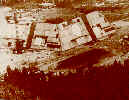 Launch after attack
- Should the SRF not launch some or most of its missiles before an
enemy attack, the Soviets have made provisions to help them survive the
attack and conduct strikes in response. Their silos and launch control
facilities, as well as their command, control, and communications links
to the Supreme High Command, are hardened and highly survivable.
Launch after attack
- Should the SRF not launch some or most of its missiles before an
enemy attack, the Soviets have made provisions to help them survive the
attack and conduct strikes in response. Their silos and launch control
facilities, as well as their command, control, and communications links
to the Supreme High Command, are hardened and highly survivable.
Command and communications entities also have mobile back-up units. To enhance survivability further, the Soviets have included both rail- and road-mobile missiles in their newest generation of ICBMs. Provisions have been made to refurbish and reload SRF silos, thereby enabling the Soviets to fire additional strategic missiles. These techniques will also be used after both sides' initial strikes during the period of prolonged nuclear conflict envisioned in Soviet doctrine.
ICBM Force Developments
 The
period 1980 to 1988 witnessed the rapid modernization and
sophistication of the Soviet ICBM arsenal. Soviet missiles have been
upgraded or replaced with new models of greater accuracy and
survivability. After 30 years of sustained growth and improvement, the
Soviet Strategic Rocket Forces are extremely capable of conducting
global nuclear strikes. Yet improvements to this force continue
unabated. By the mid-199Os, the Soviets will be fielding a completely
new generation of increasingly accurate missiles, many of them mobile,
posing a heightened threat to US strategic forces. The Soviets maintain
numerous SS- 11 and SS- 13 third-generation ICBMs. While these missiles
are not capable of destroying hardened targets, they are fully capable
of destroying unhardened targets.
The
period 1980 to 1988 witnessed the rapid modernization and
sophistication of the Soviet ICBM arsenal. Soviet missiles have been
upgraded or replaced with new models of greater accuracy and
survivability. After 30 years of sustained growth and improvement, the
Soviet Strategic Rocket Forces are extremely capable of conducting
global nuclear strikes. Yet improvements to this force continue
unabated. By the mid-199Os, the Soviets will be fielding a completely
new generation of increasingly accurate missiles, many of them mobile,
posing a heightened threat to US strategic forces. The Soviets maintain
numerous SS- 11 and SS- 13 third-generation ICBMs. While these missiles
are not capable of destroying hardened targets, they are fully capable
of destroying unhardened targets.
The centerpiece of the current Soviet SRF arsenal is the SS-18 heavy ICBM, designed to destroy hardened targets such as ICBM silos and command facilities. This missile, larger than the US PEACEKEEPER, has been modernized over the last seven years. The majority of the current force consists of SS-18 Mod 4s, which carry 10 MlRVed warheads. The SS-18 force alone could destroy 65 to 80 percent of all US ICBM silos using two warheads per target, and still have 1,000 warheads remaining. The total SS-18 force has about 3,000 warheads.
 The
Soviets have also modernized their other two fourth-generation ICBMs,
the SS-17 and SS-19. The SS- 19 Mod 3 carries six MIRVed warheads and
is roughly comparable in size to the US PEACEKEEPER. The SS-17 Mod 3,
while less accurate than the SS-18, carries four warheads and can
destroy any unhardened targets. Both the SS- 17 and SS- 19 are capable
of flexible targeting: they can hit Eurasian as well as transoceanic
targets with a total of about 2,700 warheads, thereby facilitating the
Soviet Union's ability to adjust to the situation created by the
Intermediate-range Nuclear Forces (INF) Treaty.
The
Soviets have also modernized their other two fourth-generation ICBMs,
the SS-17 and SS-19. The SS- 19 Mod 3 carries six MIRVed warheads and
is roughly comparable in size to the US PEACEKEEPER. The SS-17 Mod 3,
while less accurate than the SS-18, carries four warheads and can
destroy any unhardened targets. Both the SS- 17 and SS- 19 are capable
of flexible targeting: they can hit Eurasian as well as transoceanic
targets with a total of about 2,700 warheads, thereby facilitating the
Soviet Union's ability to adjust to the situation created by the
Intermediate-range Nuclear Forces (INF) Treaty.
The Soviets have invested enormous effort and resources in increasing the survivability of their strategic systems against nuclear attack. To make their fourth generation missiles survivable, for instance, the Soviets placed them in rebuilt, very hard silos. Of the Soviet inventory of 1,400 operational ballistic missile silos, 818 have been rebuilt since 1972. Fully one-half of these silos have been totally reconstructed and hardened since 1980.
The Soviets have begun operating fifth-generation ICBMs, missiles with
great throwweight and accuracy. They use solid-fuel propellants (which
provide longer life and require less maintenance), and are fully
mobile, and hence highly survivable. The SS-24, currently in the
initial stages of deployment, is comparable in size to the US
PEACEKEEPER. It carries 10 warheads and is designed for both rail and
silo deployment. The SS-25 is a road-mobile, 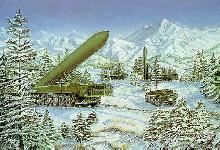 single-warhead,
three-stage system. It can fire from field deployment sites or through
the sliding roof garage it occupies at its base. The missile's mobility
makes it inherently survivable and capable of reload/refire operations.
The SS-25 joined operational Soviet SRF regiments in 1985.
single-warhead,
three-stage system. It can fire from field deployment sites or through
the sliding roof garage it occupies at its base. The missile's mobility
makes it inherently survivable and capable of reload/refire operations.
The SS-25 joined operational Soviet SRF regiments in 1985.
By the 1990s, assuming the continuation of the current modernization tempo, the Soviets will be in a position to field over 15,000 warheads. Additionally, these weapons would be placed on newer, more capable and survivable strategic delivery systems during the next decade. It is likely that by the mid-199Os, the Soviets will have completely phased out their third-generation missiles, while the fourth-generation will be undergoing replacement by systems currently in development and testing. The SS-18 Follow-On, a more accurate version than its predecessor, has been tested recently; preparations for deployment of this missile are already underway. In October 1987, the US protested the apparent Soviet intention to test the SS-18 Follow-On in such a manner as to have its reentry vehicles land in the Pacific extremely close to the major populated islands of Hawaii. Mobile, solid-fueled SS-24s and SS-25s will be fully operational and will themselves be replaced by follow-on systems in the next decade. These advances will ensure that the Soviet ICBM force will remain the world's largest and most modern strategic missile force.
Submarine-Launched Ballistic Missile Force Developments
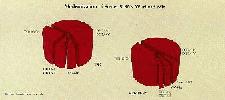 The
Soviet Navy operates the world's largest strategic missile submarine
force. Although it includes some older submarines, the majority of the
nuclear-powered ballistic missile submarine (SSBN) force consists of
more modern DELTA I, II, and III submarines armed with
intercontinental-range missiles that can reach North America from
Soviet ports and coastal waters.
The
Soviet Navy operates the world's largest strategic missile submarine
force. Although it includes some older submarines, the majority of the
nuclear-powered ballistic missile submarine (SSBN) force consists of
more modern DELTA I, II, and III submarines armed with
intercontinental-range missiles that can reach North America from
Soviet ports and coastal waters.
 Within
the last seven years, the Soviets have introduced the TYPHOON and the
DELTA IV, both equipped with more accurate, longer range MIRVed
intercontinental missiles. The introduction of these systems has
enabled the Soviets to increase their SLBM weapons delivery
capabilities by nearly 30 percent without increasing the overall size
of their SSBN force. At the same time, submarine survivability was
being significantly enhanced.
Within
the last seven years, the Soviets have introduced the TYPHOON and the
DELTA IV, both equipped with more accurate, longer range MIRVed
intercontinental missiles. The introduction of these systems has
enabled the Soviets to increase their SLBM weapons delivery
capabilities by nearly 30 percent without increasing the overall size
of their SSBN force. At the same time, submarine survivability was
being significantly enhanced.
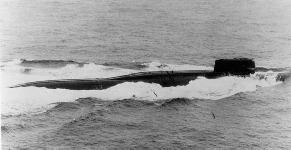 Based
in the Pacific Ocean and Northern Fleet areas, the Soviet ballistic
missile submarine force is equipped with over 3,000 warheads on
submarine-launched ballistic missiles (SLBMs). In wartime, a portion of
these forces is expected to serve as a survivable nuclear reserve. In
the last decade, the deployment of multiple warhead SLBMs with ranges
sufficient to reach the United States from waters near the USSR has
allowed the Soviets to plan to operate the majority of their SSBNs in
protected "bastions," or havens, near the Soviet Union. Mixed groups of
naval air, surface, and submarine assets, along with fixed sensors and
minefields, will operate in wartime to protect these SSBN bastion areas
against US/NATO antisubmarine forces.
Based
in the Pacific Ocean and Northern Fleet areas, the Soviet ballistic
missile submarine force is equipped with over 3,000 warheads on
submarine-launched ballistic missiles (SLBMs). In wartime, a portion of
these forces is expected to serve as a survivable nuclear reserve. In
the last decade, the deployment of multiple warhead SLBMs with ranges
sufficient to reach the United States from waters near the USSR has
allowed the Soviets to plan to operate the majority of their SSBNs in
protected "bastions," or havens, near the Soviet Union. Mixed groups of
naval air, surface, and submarine assets, along with fixed sensors and
minefields, will operate in wartime to protect these SSBN bastion areas
against US/NATO antisubmarine forces.
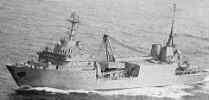 Additionally,
within the last several years the Soviet Navy has increased greatly its
interest in the Arctic as an area of military operations, particularly
for its SSBNs. The Soviets think that SSBN operations in the Arctic ice
zone could increase submarine survivability, based on their belief that
operations under and near the Arctic ice pack might provide their
deployed SSBNs with greater security and protection than in more
exposed waters.
Additionally,
within the last several years the Soviet Navy has increased greatly its
interest in the Arctic as an area of military operations, particularly
for its SSBNs. The Soviets think that SSBN operations in the Arctic ice
zone could increase submarine survivability, based on their belief that
operations under and near the Arctic ice pack might provide their
deployed SSBNs with greater security and protection than in more
exposed waters.
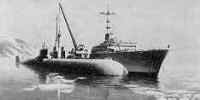 To
ensure that they can communicate with their SSBN/SLBM assets, the
Soviets have recently improved their submarine command, control, and
communications (C3) systems by deploying an extremely low
frequency (ELF) communications system. Newly deployed BEAR J aircraft
offer an additional means of effective SSBN communication redundancy by
providing very low frequency (VLF) communication transmissions to SSBNs
on patrol.
To
ensure that they can communicate with their SSBN/SLBM assets, the
Soviets have recently improved their submarine command, control, and
communications (C3) systems by deploying an extremely low
frequency (ELF) communications system. Newly deployed BEAR J aircraft
offer an additional means of effective SSBN communication redundancy by
providing very low frequency (VLF) communication transmissions to SSBNs
on patrol.
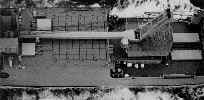 The
Soviets may begin at-sea flight testing of a modified version of the
SS-N-20 missile sometime this year. A modified version of the SS-N-23
missile will probably complete testing in 1988. Improved accuracy of
the Soviets' latest SLBM systems, as well as possible efforts to
increase SLBM reentry vehicle size and warhead yield, would confirm
Moscow's plans to develop a hard-target-kill capability for its SLBM
force. The new missile support ship class, the ALEXANDER BRYKIN, is
designed to reload SSBNs with these modern missiles. This capability
will allow Soviet SSBNs to hold additional targets at risk.
The
Soviets may begin at-sea flight testing of a modified version of the
SS-N-20 missile sometime this year. A modified version of the SS-N-23
missile will probably complete testing in 1988. Improved accuracy of
the Soviets' latest SLBM systems, as well as possible efforts to
increase SLBM reentry vehicle size and warhead yield, would confirm
Moscow's plans to develop a hard-target-kill capability for its SLBM
force. The new missile support ship class, the ALEXANDER BRYKIN, is
designed to reload SSBNs with these modern missiles. This capability
will allow Soviet SSBNs to hold additional targets at risk.
Soviet Strategic Aviation Developments
 The
Soviet intercontinental bomber force has historically lagged behind the
SRF and navy in systems development. Recent Soviet efforts in strategic
aviation, however, particularly with the BEAR H and BLACKJACK
long-range bombers, signal heightened interest in a manned-bomber
attack force to diversify the character of their strategic forces.
The
Soviet intercontinental bomber force has historically lagged behind the
SRF and navy in systems development. Recent Soviet efforts in strategic
aviation, however, particularly with the BEAR H and BLACKJACK
long-range bombers, signal heightened interest in a manned-bomber
attack force to diversify the character of their strategic forces.
The BLACKJACK is the world's largest and heaviest bomber.
Designed to carry bombs and air-launched cruise missiles (ALCMs), the
BLACKJACK can cruise subsonically over long ranges, perform
high-altitude supersonic dash, and attack utilizing low-altitude, high
subsonic penetration maneuvers. As with the B-l, the BLACKJACK has a
blended wing-body design with a variable-sweep wing and a single
vertical stabilizer. 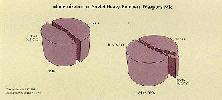 It
has an unrefueled combat radius of about 7,300 kilometers and a maximum
speed of Mach 2.0. Eleven BLACKJACK bombers have been produced, and the
first BLACKJACK regiment should begin forming this year. The backbone
of the modern Soviet intercontinental bomber force of the 1980s,
however, will remain the BEAR H, armed with the AS-15/KENT ALCM. The
Soviets also have in their inventory about 100 other BEAR bombers and
air-to-surface missile carriers. The BEAR was first produced in the
late 1950s, but some of these aircraft have been updated in subsequent
years with new technology.
It
has an unrefueled combat radius of about 7,300 kilometers and a maximum
speed of Mach 2.0. Eleven BLACKJACK bombers have been produced, and the
first BLACKJACK regiment should begin forming this year. The backbone
of the modern Soviet intercontinental bomber force of the 1980s,
however, will remain the BEAR H, armed with the AS-15/KENT ALCM. The
Soviets also have in their inventory about 100 other BEAR bombers and
air-to-surface missile carriers. The BEAR was first produced in the
late 1950s, but some of these aircraft have been updated in subsequent
years with new technology.
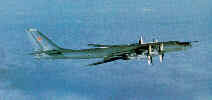 Soviet
strategic aviation capabilities are enhanced through training and
exercises. BEAR H bombers are regularly observed simulating attacks
against North America. When operational, the BLACKJACK can be expected
to engage in similar operations. Additionally, older BEAR bombers
carrying the AS-3 air-to-surface missile (ASM) are being rejuvenated
through a modification program that upgrades them to carry the newer
AS-4 supersonic ASM. More than 45 of these reconfigured aircraft,
designated BEAR Gs, are now operational.
Soviet
strategic aviation capabilities are enhanced through training and
exercises. BEAR H bombers are regularly observed simulating attacks
against North America. When operational, the BLACKJACK can be expected
to engage in similar operations. Additionally, older BEAR bombers
carrying the AS-3 air-to-surface missile (ASM) are being rejuvenated
through a modification program that upgrades them to carry the newer
AS-4 supersonic ASM. More than 45 of these reconfigured aircraft,
designated BEAR Gs, are now operational.
The current Soviet intercontinental bomber force is more flexible and survivable than it has ever been. Prior to the recent introduction of longer range cruise missiles, Soviet bombers would have had to penetrate Canadian or US airspace to launch their attacks. Now the BEAR H can launch its long-range AS-15 cruise missiles from well offshore and still hit targets in North America. The BLACKJACK will be able to conduct both standoff and penetration attacks using a variety of nuclear missiles and bombs.
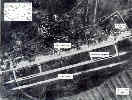 Until
recently, the Soviets had only aging BISON tankers for aerial refueling
support of BISON and BEAR aircraft. In 1987, the first unit of new
MIDAS tankers entered operational service. While the BISON tankers
remain in service, they are expected to be replaced as sufficient
numbers of MIDAS tankers become available.
Until
recently, the Soviets had only aging BISON tankers for aerial refueling
support of BISON and BEAR aircraft. In 1987, the first unit of new
MIDAS tankers entered operational service. While the BISON tankers
remain in service, they are expected to be replaced as sufficient
numbers of MIDAS tankers become available.
Cruise Missile Developments
The Soviets are on the verge of deploying a variety of sophisticated cruise missile systems. At sea, the Soviets have tested the SS-N-21 sea-launched cruise missile (SLCM). A variety of Soviet general purpose attack submarines such as VICTORs, AKULAs, or SIERRAs could carry and launch the SS-N-21. Additionally, a YANKEE-Class nuclear submarine has been converted to carry SS-N-21 missiles. Targets in either Eurasian or North American theaters could be attacked by these accurate missiles, which are fitted with nuclear warheads. The larger SS-NX-24 missile, which could be carried from specialized submarine platforms such as a modified YANKEE, is expected to be operational in the next few years.
The Soviets have deployed an air-launched long range cruise missile the AS-15/KENT with their intercontinental-range BEAR H force. Armed with this standoff weapon, the BEARs pose a much greater threat to Eurasian and US targets. Work on a new bomber-launched cruise missile is underway.
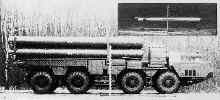 The
Soviets had developed and were preparing to deploy a ground-launched
cruise missile (GLCM)the SSC-X-4 which is a version of the
SS-N-21/AS-15 system. A GLCM-variant of the larger SS-NX-24 was also a
possibility as a theater strike weapon. Both GLCM systems are banned by
the INF Treaty.
The
Soviets had developed and were preparing to deploy a ground-launched
cruise missile (GLCM)the SSC-X-4 which is a version of the
SS-N-21/AS-15 system. A GLCM-variant of the larger SS-NX-24 was also a
possibility as a theater strike weapon. Both GLCM systems are banned by
the INF Treaty.
INTERMEDIATE-RANGE NUCLEAR FORCES
In addition to ICBMs, the SRF is responsible for intermediate-range (IRBM) and medium-range (MRBM)ballistic missiles the latter two being longer range intermediate-range nuclear forces. The INF Treaty will eliminate these Soviet systems. Until the treaty enters into force and the missiles are destroyed as required over a three-year period, INF systems, such as the SS-20, will continue to pose a threat to Eurasian targets.
The last seven years have seen the full expansion and deployment of the Soviet SS-20 IRBM force, from approximately 250 SS-20s in 1980 to a high of 441. The less capable SS-4 MRBM force has been reduced in size during this period, and now numbers approximately 50 missile launchers.
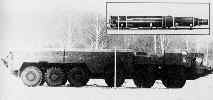 The
SS-20 is a remarkably capable IRBM system which first became
operational in 1977. The missile carries three highly accurate MIRVed
warheads and can deliver them out to a range of about 5,000 kilometers.
It has a reliable solid-fuel propellant system and is fully mobile,
making countertargeting efforts extremely difficult. It can fire either
from sliding-roof garages at regimental bases or from field-deployed
sites. The Soviets have the capability to reload and refire SS-20s. The
older SS-4 system is still maintained at the theater level. This
liquid-fueled system is located at soft launching sites. The missile
can deliver one warhead out to a range of 2,000 kilometers.
The
SS-20 is a remarkably capable IRBM system which first became
operational in 1977. The missile carries three highly accurate MIRVed
warheads and can deliver them out to a range of about 5,000 kilometers.
It has a reliable solid-fuel propellant system and is fully mobile,
making countertargeting efforts extremely difficult. It can fire either
from sliding-roof garages at regimental bases or from field-deployed
sites. The Soviets have the capability to reload and refire SS-20s. The
older SS-4 system is still maintained at the theater level. This
liquid-fueled system is located at soft launching sites. The missile
can deliver one warhead out to a range of 2,000 kilometers.
These missile forces can be augmented or replaced by a variety of other nuclear delivery systems. The Soviets retain 12 older GOLF II diesel-powered ballistic missile submarines, six of which are assigned to the Baltic Fleet. Each GOLF can deliver three SS-N-5 missiles on Eurasian targets. Additionally, Soviet aviation assets, particularly the BACKFIRE and FENCER, can conduct theater nuclear operations.
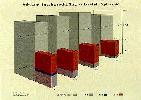 The
role of Soviet INF missiles will likely be redistributed to other
systems in light of the recent INF Treaty. The treaty requires the
destruction without replacement of all existing missiles and launchers
over a three-year period, including the SS-20, SS-4, and SS-5 ballistic
missiles, as well as the SSC-X-4 cruise missile, which was tested but
not deployed. After the agreement takes effect, however, the Soviets
maybe able to turn to other strategic ballistic missiles (ICBMs and
SLBMs), aircraft, and perhaps sea-launched cruise missiles to fulfill
their strategic theater requirements in Eurasia.
The
role of Soviet INF missiles will likely be redistributed to other
systems in light of the recent INF Treaty. The treaty requires the
destruction without replacement of all existing missiles and launchers
over a three-year period, including the SS-20, SS-4, and SS-5 ballistic
missiles, as well as the SSC-X-4 cruise missile, which was tested but
not deployed. After the agreement takes effect, however, the Soviets
maybe able to turn to other strategic ballistic missiles (ICBMs and
SLBMs), aircraft, and perhaps sea-launched cruise missiles to fulfill
their strategic theater requirements in Eurasia.
SHORT-RANGE NUCLEAR FORCES
The Soviet military also deploys a wide variety of nuclear delivery systems with a range less than 1,000 kilometers. These include shorter range intermediate-range nuclear forces (SRINF) missiles, which are covered by the INF Treaty. Specifically, the SCALEBOARD and SS-23/SPIDER will be eliminated within 18 months after the treaty enters into force. The INF Treaty does not cover short-range nuclear missiles with a range less than 500 kilometers, dual-capable aircraft, and artillery pieces. Thus, while the INF Treaty eliminates the most threatening Soviet nuclear systems, the Soviets will retain a more than adequate capability to provide tactical nuclear support for their ground forces.
The SRINF systems eliminated by the INF Treaty had posed new challenges to NATO during the 1980s. At the theater- and front-level, the older SCALEBOARD had been replaced by a modernized version. The modification significantly improved the missile's accuracy while maintaining its 900-kilometer range. Until 1983, the SCALEBOARD had not been deployed outside the USSR. In 1984, one brigade was deployed in Czechoslovakia, and two brigades were deployed in East Germany. SCALEBOARD units are also located in the western Soviet Union, and in the Central Asian and the Far Eastern USSR. Over 100 SCALEBOARD missiles remain in the inventory.
At the front- and army-levels, the SS-23/SPIDER was designed as the successor to the 1960's vintage SCUD. Over 75 are now in the inventory. With improvements in accuracy, responsiveness, and range, the SS-23 poses a greater threat to time-critical targets such as NATO nuclear missile units, airfields, and air defense sites. The SPIDER has been deployed since 1985 in several locations within the USSR and was recently introduced into East Germany. Over 600 SCUD missiles, however, remain deployed. Although SCALEBOARDs, SPIDERs, and SCUDs could be deployed with chemical or conventional high-explosive warheads, their principal role is to serve as the ground force's primary nuclear fire support means.
The Soviet military also operates tactical nuclear missile and artillery systems deployed at front level. At the division-level, nuclear fire support is provided by 660 free-rocket-over-ground (FROG) missiles, deployed in battalions of four launchers (one in each division). In 1981, the SS-21, a guided missile (providing improvement in both range and accuracy), began replacing the FROG in forward-deployed divisions, and 140 are now deployed. Division-level SS-21 battalions are being consolidated into brigades in Soviet armies in East Germany.
Soviet nuclear-capable artillery and mortars underwent qualitative improvements in the 1980s, with the replacement of older, towed-artillery pieces with self propelled (SP) versions. These SP weapons, including the 152-mm howitzer 2S3, the 152-mm gun 2S5, the 203-mm gun 2S7, and the 240-mm 2S4 mortar, enable the Soviets to provide more responsive nuclear support for their ground maneuver units.


